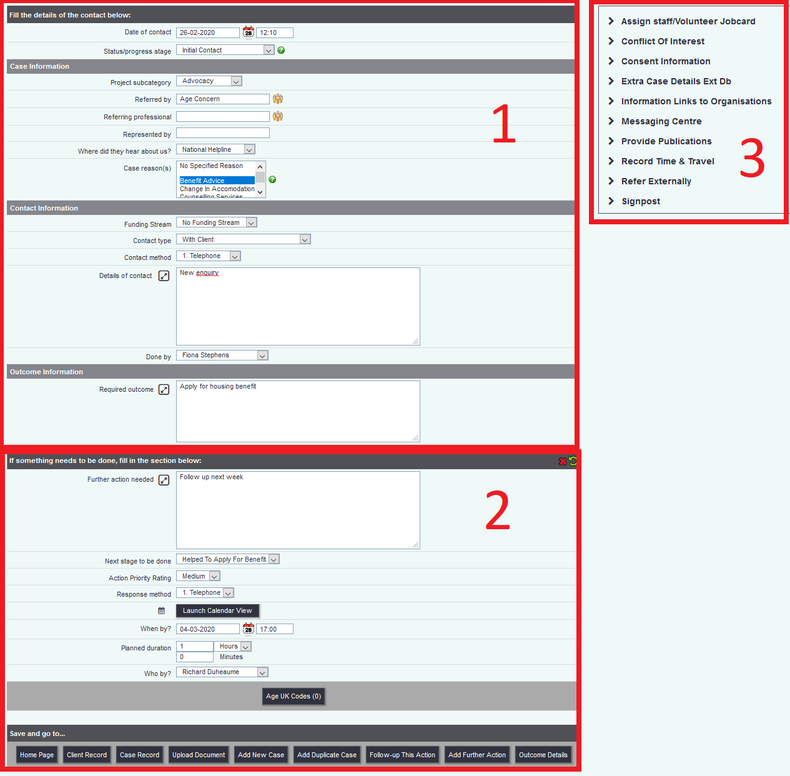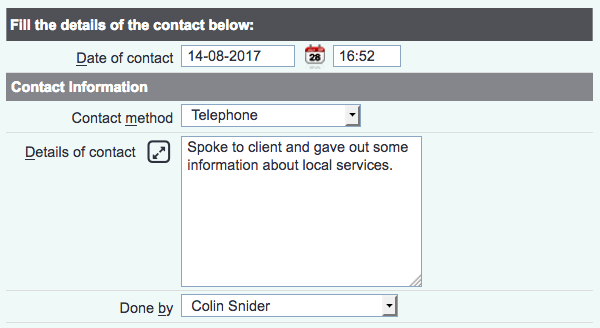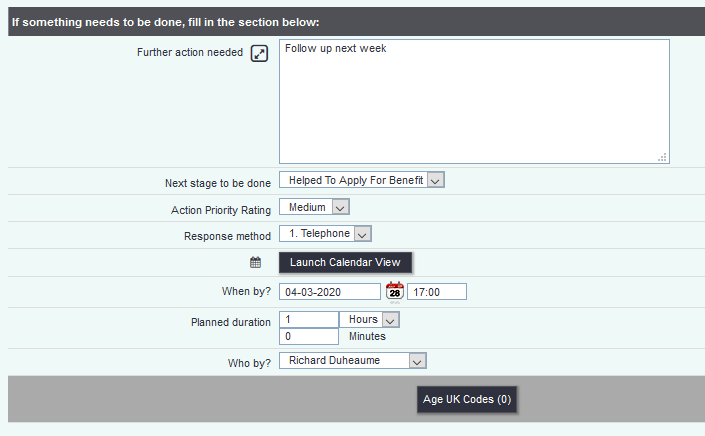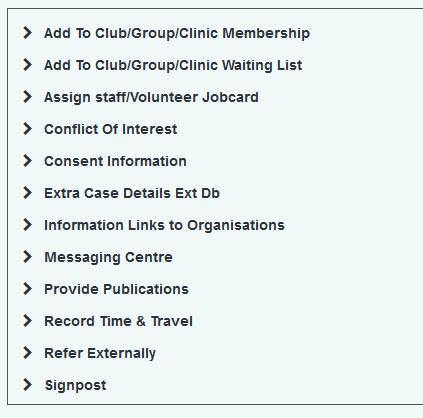Difference between revisions of "Record A Contact"
| Line 3: | Line 3: | ||
__TOC__ | __TOC__ | ||
| − | The Record a Contact Screen is one of the most-used parts of | + | The Record a Contact Screen is one of the most-used parts of the system. Every time a user records a [[Contact]] or creates an [[Action]] using the [[Contact Management]] part of the system, they will use the Record a Contact Screen to do it. Most of the time, new Referrals will also be created using this screen, as the most common way to start a Referral is to record the first Contact for that Referral. |
The screen can be broken up into three sections, as numbered in the screenshot below. | The screen can be broken up into three sections, as numbered in the screenshot below. | ||
| Line 77: | Line 77: | ||
* Response Method | * Response Method | ||
* When by? - the date that the Action needs to be done | * When by? - the date that the Action needs to be done | ||
| − | * Who by? - the person who will do this Action; that user of your | + | * Who by? - the person who will do this Action; that user of your system will receive the reminder in their [[Action List]]. |
Revision as of 09:18, 13 August 2018
The Record a Contact Screen is one of the most-used parts of the system. Every time a user records a Contact or creates an Action using the Contact Management part of the system, they will use the Record a Contact Screen to do it. Most of the time, new Referrals will also be created using this screen, as the most common way to start a Referral is to record the first Contact for that Referral.
The screen can be broken up into three sections, as numbered in the screenshot below.
- Contact (and sometimes Referral) linked information
- Action linked information
- Extra data and linked functionality
The Contact section
This is where you record details of the contact, i.e. the work that has been done.
Mandatory data
For every Contact you will need to enter:
- the date of the contact (this will be automatically filled in with today's date, but can be manually changed to any date)
- the details of the contact (some text; this is the narrative that will form the History about the work done)
Where do Contacts go?
Once Contacts are recorded, they are displayed on the History tab (part of the Details Screen for the person that they relate to. This means that all users can go and view details of the Contacts that have happened over time (as long as the user has the relevant access permissions).
They are also saved for reporting. It's easy to produce a report showing how many contacts have been recorded during a time period, how many of those were home visits, how many related to a particular service, and so on.
Optional data on Contacts
Depending on the way your system administrators have set your system up, you may also need to record one or more of the following:
Referral-linked data (which will only show on the first Contact in each Referral)
- Referred By - which organisation or person referred this piece of work to you. This uses the list of Referrers.
- Secondary org/person - another organisation or person (whose details are on your system) that you want to associate with this Referral.
- Represented By - free text; your system administrators will give guidance as to how to use it, if it appears on your system.
- Where did they hear about us? - This field uses the list of Referral Sources, and is intended to help you measure the effectiveness of advertising and marketing.
- Project Subcategory - see Project Subcategories.
- Referral Reason(s) - this field uses the list of Referral Reasons.
- Required Outcome - free text.
- Template stage - see Referral Templates.
- Classification Codes - see Classification Codes.
Contact-linked data
- Contact Type - select from the list of Contact Types.
- Classification Codes - see Classification Codes.
The Action section
This is where you can record details of an Action that needs to be done. You do not have to enter an Action - if there is no Action to be done, simply leave the section blank.
Mandatory Data
If you are going to enter an outstanding Action, you will need to enter:
- Further Action needed (this is the description of the Action that will be shown to the person nominated to do it)
- Response Method
- When by? - the date that the Action needs to be done
- Who by? - the person who will do this Action; that user of your system will receive the reminder in their Action List.
Where do Actions go?
Actions, like Contacts, will appear on the History tab for the person they relate to (that is, the client/service user/etc). This means that any user of the system can look at a person's Details Screen and see any work which is outstanding. More importantly, Actions will appear on the Action List of the user that has been nominated to do them. This means that the Action List can replace emails, paper diaries, post-it notes and so on.
Optional Data on Actions
Depending on the way your system administrators have set your system up, you may also need to record one or more of the following:
- Priority Rating - choose from "No Rating", "Low", "Medium", "High" or "Very High".
- Planned Duration
Options section
The Options section contains various headings. Clicking any of the headings in the Options section will pop up a window for you to enter data. The headings that appear in the Options section depend on the way your system is configured, and what other elements exist in the system, but the minimum is likely to be as shown:
- Record Time & Travel
- Signposting and External Referrals
- Assign Staff/Volunteer Jobcard
Extra headings in the Options section
Depending on your system setup, you may also see one or more of the following:
- Add To Club/Group/Clinic Waiting List
- Add To Club/Group/Clinic Membership
- Information Links to Organisations
- Provide Publications
- Conflict of Interest
- Consent Information
- Messaging Centre
Save and Go To...
All of the buttons at the bottom of the Record a Contact screen will save the data you have entered, but each button will then perform a different action and/or take you to a different place.
- ...Home Page will take you to your Home page - whichever page you see when you first log in.
- ...Record will take you to the Details screen of whichever organisation/person you have been recording work for. For example, if you have been working with/for a Client, you will be returned to their Client Details screen.
- ...Referral Record will take you to the diary view of the Referral.
- ...Upload Document will take you to the Uploaded Documents screen for the org/person you have been working with. The "Relevant Referral No." field will automatically be filled in with the number of the referral you have come from.
- ...Add New Referral will take you back to the Existing/New Referrals screen so that you can enter another referral for the same person.
- ...Add Duplicate Referral will also take you back to the Existing/New Referrals Screen so that you can enter another referral for the same person, but details from the current referral will be copied to the new one (Contact Method, Details of Contact, etc).
- ...Follow-up This Action will let you immediately add a Contact/Action/both to this referral. You will be shown the referral with Extra Info, Further Action and (if appropriate) Update buttons.
- ...Add Further Action will let you add an outstanding Action to this referral - as if you'd clicked the "Further Action" button on the History page.
- ...Outcome Details (or Ladder Outcomes, if you are using them) will take you to the Referral Closure and Outcome Details screen for this Referral.
Rob Kay - manual author (talk) 17:07, 14 August 2017 (BST)





